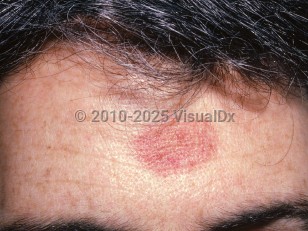Traumatic purpura in Adult
Alerts and Notices
Important News & Links
Synopsis

It is important to note that some varieties of purpura may be a sign of emergency. Varieties dealt with here may be more prone to occur in the setting of low platelet count or bleeding diathesis.
Purpura in the form of ecchymoses, or bruising, typically follows trauma, pressure, or other physical forces to the skin. Traumatic purpura is typically accidental, but factitial or self-induced cases occur frequently as well. Severe vomiting, coughing (Valsalva purpura), or other causes of increased venous pressure can cause subconjunctival hemorrhage or eyelid or periorbital petechiae or bruising. Suction to the skin can be self-induced (typical in children but also seen in adults). The most common cause of purpura is trauma from falls and blows to the skin. Bateman purpura (also known as solar, actinic, or senile purpura) is the term used to describe the ecchymoses of the forearms caused by minor or even imperceptible trauma to skin fragility, as seen in elderly and/or severely sun-damaged individuals. Large raised areas of purpura are considered hematomas. Chronically enlarging hematomas may be a sign of vascular malignancy, eg, angiosarcoma.
Ecchymoses around the mastoid bone and below the ear can be associated with head trauma and temporal bone fracture. Appropriate radiologic studies and neurological evaluation are required, as acute epidural hematoma may be associated. Ecchymoses in this location are often referred to as Battle's sign.
Purpura in the form of ecchymoses, or bruising, typically follows trauma, pressure, or other physical forces to the skin. Traumatic purpura is typically accidental, but factitial or self-induced cases occur frequently as well. Severe vomiting, coughing (Valsalva purpura), or other causes of increased venous pressure can cause subconjunctival hemorrhage or eyelid or periorbital petechiae or bruising. Suction to the skin can be self-induced (typical in children but also seen in adults). The most common cause of purpura is trauma from falls and blows to the skin. Bateman purpura (also known as solar, actinic, or senile purpura) is the term used to describe the ecchymoses of the forearms caused by minor or even imperceptible trauma to skin fragility, as seen in elderly and/or severely sun-damaged individuals. Large raised areas of purpura are considered hematomas. Chronically enlarging hematomas may be a sign of vascular malignancy, eg, angiosarcoma.
Ecchymoses around the mastoid bone and below the ear can be associated with head trauma and temporal bone fracture. Appropriate radiologic studies and neurological evaluation are required, as acute epidural hematoma may be associated. Ecchymoses in this location are often referred to as Battle's sign.
Codes
ICD10CM:
D69.2 – Other nonthrombocytopenic purpura
SNOMEDCT:
125667009 – Contusion
D69.2 – Other nonthrombocytopenic purpura
SNOMEDCT:
125667009 – Contusion
Look For
Subscription Required
Diagnostic Pearls
Subscription Required
Differential Diagnosis & Pitfalls

To perform a comparison, select diagnoses from the classic differential
Subscription Required
Best Tests
Subscription Required
Management Pearls
Subscription Required
Therapy
Subscription Required
References
Subscription Required
Last Updated:12/10/2020
Traumatic purpura in Adult

